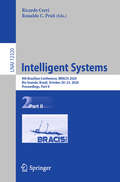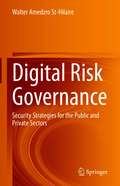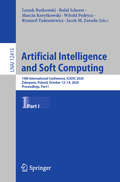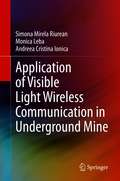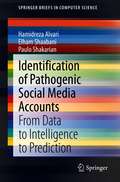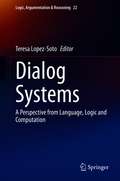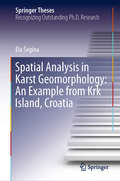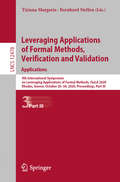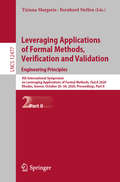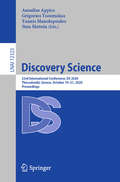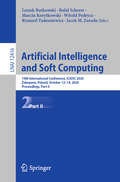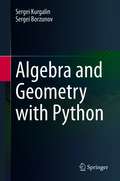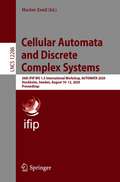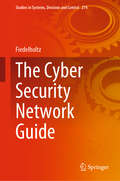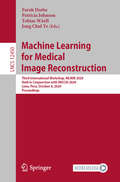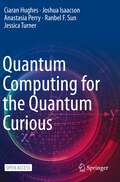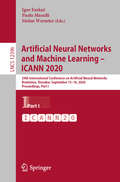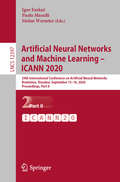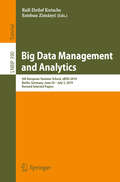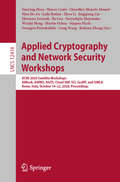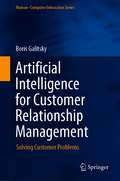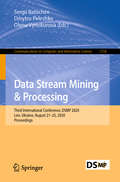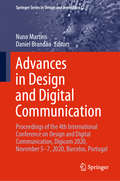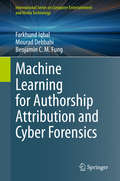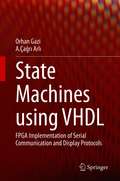- Table View
- List View
Intelligent Systems: 9th Brazilian Conference, BRACIS 2020, Rio Grande, Brazil, October 20–23, 2020, Proceedings, Part II (Lecture Notes in Computer Science #12320)
by Ricardo Cerri Ronaldo C. PratiThe two-volume set LNAI 12319 and 12320 constitutes the proceedings of the 9th Brazilian Conference on Intelligent Systems, BRACIS 2020, held in Rio Grande, Brazil, in October 2020. The total of 90 papers presented in these two volumes was carefully reviewed and selected from 228 submissions. The contributions are organized in the following topical section: Part I: Evolutionary computation, metaheuristics, constrains and search, combinatorial and numerical optimization; neural networks, deep learning and computer vision; and text mining and natural language processing. Part II: Agent and multi-agent systems, planning and reinforcement learning; knowledge representation, logic and fuzzy systems; machine learning and data mining; and multidisciplinary artificial and computational intelligence and applications.Due to the Corona pandemic BRACIS 2020 was held as a virtual event.
Digital Risk Governance: Security Strategies for the Public and Private Sectors
by Walter Amedzro St-HilaireThis book discusses digital risk governance in a global context and provides practical solutions for sound digital policy. From cyber-attacks to the mechanisms of digital technical management on a global scale, this book identifies the fundamental areas of digital vulnerability for both states and businesses and outlines the means of securing them. Written with the digital security needs of the public and private sectors in mind, chapters provide approachable guidance on navigating national digital strategies for public and corporate cyber-risks, identifying mechanisms for embedding digital security over time, protecting both personal and strategic economic data, adapting regulations to digital challenges, and leveraging innovation and multilateralism for digital security. Providing a comprehensive view of digital risk mechanisms for multiple stakeholders, this volume will be useful for professionals and practitioners in technology governance, digital management, IS/risk management, digital security, and internet policy.
Artificial Intelligence and Soft Computing: 19th International Conference, ICAISC 2020, Zakopane, Poland, October 12-14, 2020, Proceedings, Part I (Lecture Notes in Computer Science #12415)
by Leszek Rutkowski Rafał Scherer Marcin Korytkowski Witold Pedrycz Ryszard Tadeusiewicz Jacek M. ZuradaThe two-volume set LNCS 12415 and 12416 constitutes the refereed proceedings of of the 19th International Conference on Artificial Intelligence and Soft Computing, ICAISC 2020, held in Zakopane, Poland*, in October 2020.The 112 revised full papers presented were carefully reviewed and selected from 265 submissions. The papers included in the first volume are organized in the following six parts: neural networks and their applications; fuzzy systems and their applications; evolutionary algorithms and their applications; pattern classification; bioinformatics, biometrics and medical applications; artificial intelligence in modeling and simulation.The papers included in the second volume are organized in the following four parts: computer vision, image and speech analysis; data mining; various problems of artificial intelligence; agent systems, robotics and control.*The conference was held virtually due to the COVID-19 pandemic.
Application of Visible Light Wireless Communication in Underground Mine
by Simona Mirela Riurean Monica Leba Andreea Cristina IonicaThis book provides a chronological literature review of optical wireless communication, followed by a detailed blueprint of a visible light communication (VLC) setup with the key characteristics of LEDs and photodetectors. Next, the optical channel impulse response and its description for different possible topologies is presented together with a description of the optical and electrical setup for both optical transmitters (oTx) and optical receivers (oRx). Different single carrier and multi-carrier modulations particularly applied in visible light communication setups are also presented. Both the optical and electrical modules of oTx and oRx are simulated and then prototyped and tested as embedded devices in an underground positioning and monitoring system for a continuous real time identification of the personnel on the main underground galleries where the illumination network is already installed.Presents a comprehensive look at visible light communication technology, both in description and application;Shows where and how VLC has been launched on the market as an alternative or partner technology to the existing wireless communication technologies based on radio frequency;Includes special focus on underground positioning and monitoring with embedded VLC.
Identification of Pathogenic Social Media Accounts: From Data to Intelligence to Prediction (SpringerBriefs in Computer Science)
by Hamidreza Alvari Elham Shaabani Paulo ShakarianThis book sheds light on the challenges facing social media in combating malicious accounts, and aims to introduce current practices to address the challenges. It further provides an in-depth investigation regarding characteristics of “Pathogenic Social Media (PSM),”by focusing on how they differ from other social bots (e.g., trolls, sybils and cyborgs) and normal users as well as how PSMs communicate to achieve their malicious goals. This book leverages sophisticated data mining and machine learning techniques for early identification of PSMs, using the relevant information produced by these bad actors. It also presents proactive intelligence with a multidisciplinary approach that combines machine learning, data mining, causality analysis and social network analysis, providing defenders with the ability to detect these actors that are more likely to form malicious campaigns and spread harmful disinformation. Over the past years, social media has played a major role in massive dissemination of misinformation online. Political events and public opinion on the Web have been allegedly manipulated by several forms of accounts including “Pathogenic Social Media (PSM)” accounts (e.g., ISIS supporters and fake news writers). PSMs are key users in spreading misinformation on social media - in viral proportions. Early identification of PSMs is thus of utmost importance for social media authorities in an effort toward stopping their propaganda. The burden falls to automatic approaches that can identify these accounts shortly after they began their harmful activities. Researchers and advanced-level students studying and working in cybersecurity, data mining, machine learning, social network analysis and sociology will find this book useful. Practitioners of proactive cyber threat intelligence and social media authorities will also find this book interesting and insightful, as it presents an important and emerging type of threat intelligence facing social media and the general public.
Dialog Systems: A Perspective from Language, Logic and Computation (Logic, Argumentation & Reasoning #22)
by Teresa Lopez-SotoThis book focuses on dialog from a varied combination of fields: Linguistics, Philosophy of Language and Computation. It builds on the hypothesis that meaning in human communication arises at the discourse level rather than at the word level. The book offers a complex analytical framework and integration of the central areas of research around human communication. The content revolves around meaning but it also gives evidence of the connection among different points of view. Besides discussing issues of general interest to the field, the book triggers theoretical argumentation that is currently under scientific discussion. It examines such topics as immanent reasoning joined with Recanati's lekta and free enrichment, challenges of internet conversation, inner dialogs, cognition and language, and the relation between assertion and denial. It proposes a dialogical framework for intra-negotiation and gives a geolinguistic perspective on spoken discourse. Finally, it examines dialog and abduction and sheds light on a generation of dialog contexts by means of multimodal logic applied to speech acts.
Spatial Analysis in Karst Geomorphology: An Example from Krk Island, Croatia (Springer Theses)
by Ela ŠeginaThis book presents (i) a comprehensive methodological approach in analyzing karst surface features using contemporary GIS tools of high resolution applied on a large study area and extensive dataset, (ii) a revision and evaluation of the existing concepts valid in the modern karst geomorphology, (iii) a detailed elaboration of overlooked and yet undefined karst surface features, and (iv) an innovation in the discussion on origin and evolution of karst surface features. The book contains the first example of such comprehensive application of the modern technologies in spatial analysis in the field of karst geomorphology, and it offers several new methodological and theoretical perspectives and presents numerous starting points for further research. It contributes both to the understanding of the local karst evolution and to the knowledge of karst surface features globally.
Leveraging Applications of Formal Methods, Verification and Validation: 9th International Symposium on Leveraging Applications of Formal Methods, ISoLA 2020, Rhodes, Greece, October 20–30, 2020, Proceedings, Part III (Lecture Notes in Computer Science #12478)
by Tiziana Margaria Bernhard SteffenThe three-volume set LNCS 12476 - 12478 constitutes the refereed proceedings of the 9th International Symposium on Leveraging Applications of Formal Methods, ISoLA 2020, which was planned to take place during October 20–30, 2020, on Rhodes, Greece. The event itself was postponed to 2021 due to the COVID-19 pandemic. The papers presented were carefully reviewed and selected for inclusion in the proceedings. Each volume focusses on an individual topic with topical section headings within the volume:Part I, Verification Principles: Modularity and (De-)Composition in Verification; X-by-Construction: Correctness meets Probability; 30 Years of Statistical Model Checking; Verification and Validation of Concurrent and Distributed Systems. Part II, Engineering Principles: Automating Software Re-Engineering; Rigorous Engineering of Collective Adaptive Systems. Part III, Applications: Reliable Smart Contracts: State-of-the-art, Applications, Challenges and Future Directions; Automated Verification of Embedded Control Software; Formal methods for DIStributed COmputing in future RAILway systems.
Leveraging Applications of Formal Methods, Verification and Validation: 9th International Symposium on Leveraging Applications of Formal Methods, ISoLA 2020, Rhodes, Greece, October 20–30, 2020, Proceedings, Part II (Lecture Notes in Computer Science #12477)
by Tiziana Margaria Bernhard SteffenThe three-volume set LNCS 12476 - 12478 constitutes the refereed proceedings of the 9th International Symposium on Leveraging Applications of Formal Methods, ISoLA 2020, which was planned to take place during October 20–30, 2020, on Rhodes, Greece. The event itself was postponed to 2021 due to the COVID-19 pandemic. The papers presented were carefully reviewed and selected for inclusion in the proceedings. Each volume focusses on an individual topic with topical section headings within the volume:Part I, Verification Principles: Modularity and (De-)Composition in Verification; X-by-Construction: Correctness meets Probability; 30 Years of Statistical Model Checking; Verification and Validation of Concurrent and Distributed Systems. Part II, Engineering Principles: Automating Software Re-Engineering; Rigorous Engineering of Collective Adaptive Systems. Part III, Applications: Reliable Smart Contracts: State-of-the-art, Applications, Challenges and Future Directions; Automated Verification of Embedded Control Software; Formal methods for DIStributed COmputing in future RAILway systems.
Discovery Science: 23rd International Conference, DS 2020, Thessaloniki, Greece, October 19–21, 2020, Proceedings (Lecture Notes in Computer Science #12323)
by Annalisa Appice Grigorios Tsoumakas Yannis Manolopoulos Stan MatwinThis book constitutes the proceedings of the 23rd International Conference on Discovery Science, DS 2020, which took place during October 19-21, 2020. The conference was planned to take place in Thessaloniki, Greece, but had to change to an online format due to the COVID-19 pandemic. The 26 full and 19 short papers presented in this volume were carefully reviewed and selected from 76 submissions. The contributions were organized in topical sections named: classification; clustering; data and knowledge representation; data streams; distributed processing; ensembles; explainable and interpretable machine learning; graph and network mining; multi-target models; neural networks and deep learning; and spatial, temporal and spatiotemporal data.
Artificial Intelligence and Soft Computing: 19th International Conference, ICAISC 2020, Zakopane, Poland, October 12-14, 2020, Proceedings, Part II (Lecture Notes in Computer Science #12416)
by Leszek Rutkowski Rafał Scherer Marcin Korytkowski Witold Pedrycz Ryszard Tadeusiewicz Jacek M. ZuradaThe two-volume set LNCS 12415 and 12416 constitutes the refereed proceedings of of the 19th International Conference on Artificial Intelligence and Soft Computing, ICAISC 2020, held in Zakopane, Poland*, in October 2020.The 112 revised full papers presented were carefully reviewed and selected from 265 submissions. The papers included in the first volume are organized in the following six parts: neural networks and their applications; fuzzy systems and their applications; evolutionary algorithms and their applications; pattern classification; bioinformatics, biometrics and medical applications; artificial intelligence in modeling and simulation.The papers included in the second volume are organized in the following four parts: computer vision, image and speech analysis; data mining; various problems of artificial intelligence; agent systems, robotics and control.*The conference was held virtually due to the COVID-19 pandemic.
Algebra and Geometry with Python
by Sergei Kurgalin Sergei BorzunovThis book teaches algebra and geometry. The authors dedicate chapters to the key issues of matrices, linear equations, matrix algorithms, vector spaces, lines, planes, second-order curves, and elliptic curves. The text is supported throughout with problems, and the authors have included source code in Python in the book. The book is suitable for advanced undergraduate and graduate students in computer science.
Cellular Automata and Discrete Complex Systems: 26th IFIP WG 1.5 International Workshop, AUTOMATA 2020, Stockholm, Sweden, August 10–12, 2020, Proceedings (Lecture Notes in Computer Science #12286)
by Hector ZenilThis volume constitutes the refereed post-conference proceedings of the 26th IFIP WG 1.5 International Workshop on Cellular Automata and Discrete Complex Systems, AUTOMATA 2020, held in Stockholm, Sweden, in August 2020. The workshop was held virtually.The 11 full papers presented in this book were carefully reviewed and selected from a total of 21 submissions. The topics of the conference include dynamical, topological, ergodic and algebraic aspects of CA and DCS, algorithmic and complexity issues, emergent properties, formal languages, symbolic dynamics, tilings, models of parallelism and distributed systems, timing schemes, synchronous versus asynchronous models, phenomenological descriptions, scientific modeling, and practical applications.
The Cyber Security Network Guide (Studies in Systems, Decision and Control #274)
by FiedelholtzThis book presents a unique, step-by-step approach for monitoring, detecting, analyzing and mitigating complex network cyber threats. It includes updated processes in response to asymmetric threats, as well as descriptions of the current tools to mitigate cyber threats. Featuring comprehensive computer science material relating to a complete network baseline with the characterization hardware and software configuration, the book also identifies potential emerging cyber threats and the vulnerabilities of the network architecture to provide students with a guide to responding to threats. The book is intended for undergraduate and graduate college students who are unfamiliar with the cyber paradigm and processes in responding to attacks.
Machine Learning for Medical Image Reconstruction: Third International Workshop, MLMIR 2020, Held in Conjunction with MICCAI 2020, Lima, Peru, October 8, 2020, Proceedings (Lecture Notes in Computer Science #12450)
by Farah Deeba Patricia Johnson Tobias Würfl Jong Chul YeThis book constitutes the refereed proceedings of the Third International Workshop on Machine Learning for Medical Reconstruction, MLMIR 2020, held in conjunction with MICCAI 2020, in Lima, Peru, in October 2020. The workshop was held virtually. The 15 papers presented were carefully reviewed and selected from 18 submissions. The papers are organized in the following topical sections: deep learning for magnetic resonance imaging and deep learning for general image reconstruction.
Quantum Computing for the Quantum Curious
by Jessica Turner Ciaran Hughes Joshua Isaacson Anastasia Perry Ranbel F. SunThis open access book makes quantum computing more accessible than ever before. A fast-growing field at the intersection of physics and computer science, quantum computing promises to have revolutionary capabilities far surpassing “classical” computation. Getting a grip on the science behind the hype can be tough: at its heart lies quantum mechanics, whose enigmatic concepts can be imposing for the novice. This classroom-tested textbook uses simple language, minimal math, and plenty of examples to explain the three key principles behind quantum computers: superposition, quantum measurement, and entanglement. It then goes on to explain how this quantum world opens up a whole new paradigm of computing. The book bridges the gap between popular science articles and advanced textbooks by making key ideas accessible with just high school physics as a prerequisite. Each unit is broken down into sections labelled by difficulty level, allowing the course to be tailored to the student’s experience of math and abstract reasoning. Problem sets and simulation-based labs of various levels reinforce the concepts described in the text and give the reader hands-on experience running quantum programs. This book can thus be used at the high school level after the AP or IB exams, in an extracurricular club, or as an independent project resource to give students a taste of what quantum computing is really about. At the college level, it can be used as a supplementary text to enhance a variety of courses in science and computing, or as a self-study guide for students who want to get ahead. Additionally, readers in business, finance, or industry will find it a quick and useful primer on the science behind computing’s future.
Artificial Neural Networks and Machine Learning – ICANN 2020: 29th International Conference on Artificial Neural Networks, Bratislava, Slovakia, September 15–18, 2020, Proceedings, Part I (Lecture Notes in Computer Science #12396)
by Igor Farkaš Paolo Masulli Stefan WermterThe proceedings set LNCS 12396 and 12397 constitute the proceedings of the 29th International Conference on Artificial Neural Networks, ICANN 2020, held in Bratislava, Slovakia, in September 2020.*The total of 139 full papers presented in these proceedings was carefully reviewed and selected from 249 submissions. They were organized in 2 volumes focusing on topics such as adversarial machine learning, bioinformatics and biosignal analysis, cognitive models, neural network theory and information theoretic learning, and robotics and neural models of perception and action. *The conference was postponed to 2021 due to the COVID-19 pandemic.
Artificial Neural Networks and Machine Learning – ICANN 2020: 29th International Conference on Artificial Neural Networks, Bratislava, Slovakia, September 15–18, 2020, Proceedings, Part II (Lecture Notes in Computer Science #12397)
by Igor Farkaš Paolo Masulli Stefan WermterThe proceedings set LNCS 12396 and 12397 constitute the proceedings of the 29th International Conference on Artificial Neural Networks, ICANN 2020, held in Bratislava, Slovakia, in September 2020.*The total of 139 full papers presented in these proceedings was carefully reviewed and selected from 249 submissions. They were organized in 2 volumes focusing on topics such as adversarial machine learning, bioinformatics and biosignal analysis, cognitive models, neural network theory and information theoretic learning, and robotics and neural models of perception and action. *The conference was postponed to 2021 due to the COVID-19 pandemic.
Big Data Management and Analytics: 9th European Summer School, eBISS 2019, Berlin, Germany, June 30 – July 5, 2019, Revised Selected Papers (Lecture Notes in Business Information Processing #390)
by Ralf-Detlef Kutsche Esteban ZimányiThis book constitutes 5 revised tutorial lectures of the 9th European Business Intelligence and Big Data Summer School, eBISS 2019, held in Berlin, Germany, during June 30 – July 5, 2019. The tutorials were given by renowned experts and covered advanced aspects of business intelligence and big data. This summer school, presented by leading researchers in the field, represented an opportunity for postgraduate students to equip themselves with the theoretical and practical skills necessary for developing challenging business intelligence applications.
Applied Cryptography and Network Security Workshops: ACNS 2020 Satellite Workshops, AIBlock, AIHWS, AIoTS, Cloud S&P, SCI, SecMT, and SiMLA, Rome, Italy, October 19–22, 2020, Proceedings (Lecture Notes in Computer Science #12418)
by Jianying Zhou Mauro Conti Chuadhry Mujeeb Ahmed Man Ho Au Lejla Batina Zhou Li Jingqiang Lin Eleonora Losiouk Bo Luo Suryadipta Majumdar Weizhi Meng Martín Ochoa Stjepan Picek Georgios Portokalidis Cong Wang Kehuan ZhangThis book constitutes the proceedings of the satellite workshops held around the 18th International Conference on Applied Cryptography and Network Security, ACNS 2020, in Rome, Italy, in October 2020. The 31 papers presented in this volume were carefully reviewed and selected from 65 submissions. They stem from the following workshops: AIBlock 2020:Second International Workshop on Application Intelligence and Blockchain Security AIHWS 2020:First International Workshop on Artificial Intelligence in Hardware Security AIoTS 2020:Second International Workshop on Artificial Intelligence and Industrial Internet-of-Things Security Cloud S&P 2020:Second International Workshop on Cloud Security and Privacy SCI 2020:First International Workshop on Secure Cryptographic Implementation SecMT 2020:First International Workshop on Security in Mobile Technologies SiMLA 2020: Second International Workshop on Security in Machine Learning and its Applications
Artificial Intelligence for Customer Relationship Management: Solving Customer Problems (Human–Computer Interaction Series)
by Boris GalitskyThe second volume of this research monograph describes a number of applications of Artificial Intelligence in the field of Customer Relationship Management with the focus of solving customer problems. We design a system that tries to understand the customer complaint, his mood, and what can be done to resolve an issue with the product or service. To solve a customer problem efficiently, we maintain a dialogue with the customer so that the problem can be clarified and multiple ways to fix it can be sought. We introduce dialogue management based on discourse analysis: a systematic linguistic way to handle the thought process of the author of the content to be delivered. We analyze user sentiments and personal traits to tailor dialogue management to individual customers. We also design a number of dialogue scenarios for CRM with replies following certain patterns and propose virtual and social dialogues for various modalities of communication with a customer. After we learn to detect fake content, deception and hypocrisy, we examine the domain of customer complaints. We simulate mental states, attitudes and emotions of a complainant and try to predict his behavior. Having suggested graph-based formal representations of complaint scenarios, we machine-learn them to identify the best action the customer support organization can chose to retain the complainant as a customer.
Data Stream Mining & Processing: Third International Conference, DSMP 2020, Lviv, Ukraine, August 21–25, 2020, Proceedings (Communications in Computer and Information Science #1158)
by Sergii Babichev Dmytro Peleshko Olena VynokurovaThis book constitutes the proceedings of the third International Conference on Data Stream and Mining and Processing, DSMP 2020, held in Lviv, Ukraine*, in August 2020.The 36 full papers presented in this volume were carefully reviewed and selected from 134 submissions. The papers are organized in topical sections of hybrid systems of computational intelligence; machine vision and pattern recognition; dynamic data mining & data stream mining; big data & data science using intelligent approaches.*The conference was held virtually due to the COVID-19 pandemic.
Advances in Design and Digital Communication: Proceedings of the 4th International Conference on Design and Digital Communication, Digicom 2020, November 5–7, 2020, Barcelos, Portugal (Springer Series in Design and Innovation #12)
by Nuno Martins Daniel BrandãoThis book reports on research findings and practical lessons featuring advances in: digital and interaction design; graphic design and branding; design strategies and methodologies; design education; society and communication in design practice; and other related areas. Gathering the proceedings of the 4th International Conference on Digital Design and Communication, Digicom 2020, held virtually on November 5-6, 2020, the book describes cutting-edge perspectives on and analysis of and solutions to challenges digital communication is currently presenting to society, institutions and brands. It offers a timely guide and a source of inspiration for designers of all kinds, including graphic, digital and web designers, UI, UX and social media designers, and to researchers, advertisers, artists, and entrepreneurs, as well as brand or corporate communication managers.
Machine Learning for Authorship Attribution and Cyber Forensics (International Series on Computer Entertainment and Media Technology)
by Farkhund Iqbal Mourad Debbabi Benjamin C. FungThe book first explores the cybersecurity’s landscape and the inherent susceptibility of online communication system such as e-mail, chat conversation and social media in cybercrimes. Common sources and resources of digital crimes, their causes and effects together with the emerging threats for society are illustrated in this book. This book not only explores the growing needs of cybersecurity and digital forensics but also investigates relevant technologies and methods to meet the said needs. Knowledge discovery, machine learning and data analytics are explored for collecting cyber-intelligence and forensics evidence on cybercrimes.Online communication documents, which are the main source of cybercrimes are investigated from two perspectives: the crime and the criminal. AI and machine learning methods are applied to detect illegal and criminal activities such as bot distribution, drug trafficking and child pornography. Authorship analysis is applied to identify the potential suspects and their social linguistics characteristics. Deep learning together with frequent pattern mining and link mining techniques are applied to trace the potential collaborators of the identified criminals.Finally, the aim of the book is not only to investigate the crimes and identify the potential suspects but, as well, to collect solid and precise forensics evidence to prosecute the suspects in the court of law.
State Machines using VHDL: FPGA Implementation of Serial Communication and Display Protocols
by Orhan Gazi A.Çağrı ArlıThis textbook teaches students techniques for the design of advanced digital systems using Field Programmable Gate Arrays (FPGAs). The authors focus on communication between FPGAs and peripheral devices (such as EEPROM, analog-to-digital converters, sensors, digital-to-analog converters, displays etc.) and in particular state machines and timed state machines for the implementation of serial communication protocols, such as UART, SPI, I²C, and display protocols, such as VGA, HDMI. VHDL is used as the programming language and all topics are covered in a structured, step-by-step manner.
